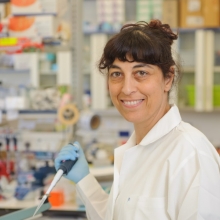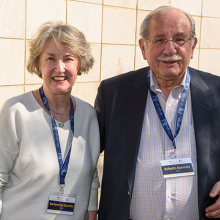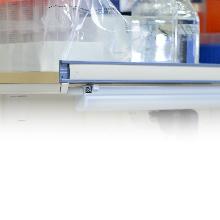Rx for the ocean
The largest bodies of water need our urgent attention
Features
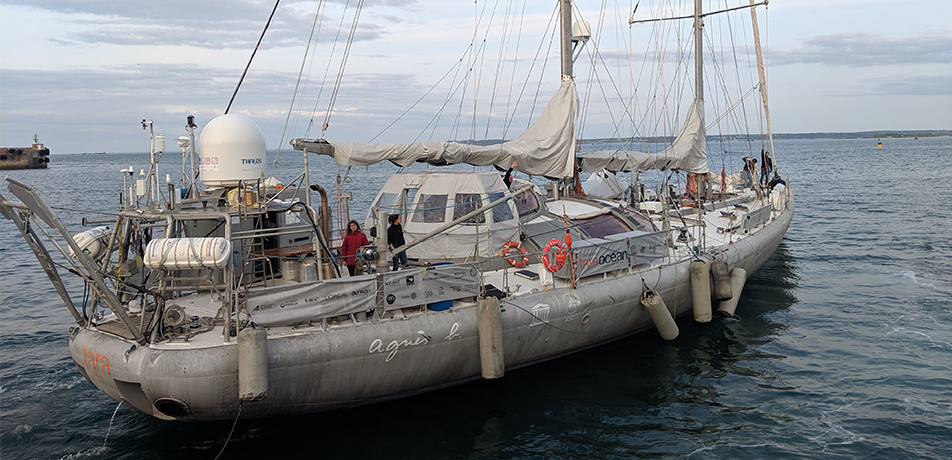
The Tara research vessel on which Weizmann research has been conducted
Take a breath. Now take another breath. Every second breath you take comes from the ocean.
Covering 72 percent of the Earth and supplying half its oxygen, the ocean is our planet’s life support system—regulating climate, and providing food for an infinite variety of species, including our own. And here’s something you might not think about: The ocean is home to the Earth’s largest mountain ranges and its deepest canyons, and at the same time is the world’s most diverse habitat, sheltering the plants and animals that make up 80 percent of life on Earth.

Prof. Assaf Vardi
Humans are deeply dependent on the ocean, but you might not think so based on human behavior. Unlike the 12 percent of our planet’s total land mass that is legally set aside for preservation, less than 2 percent of the ocean is similarly protected. Fishing has sent the majority of the ocean’s large predators into extinction. Pollution, which has already destroyed 20 percent of our coral reefs, is damaging niche ecosystems in ways we are only beginning to understand. And humankind has yet to mount a serious response to climate change—the documented rise in global temperatures that is causing the ocean to get warmer and more acidic. That’s despite increasingly dire projections that the rising water levels, increased storm activity, and flooding we are experiencing will only get worse in the coming years.
If we want to preserve our precious water ecosystems, we must first understand them. A range of research projects on the oceans and, in particular, the Mediterranean Sea, are now underway at the Weizmann Institute. These projects, carried out in the labs of the Department of Earth and Planetary Sciences, the Department of Plant and Environmental Science, and elsewhere on campus, are creating a more integrated understanding of the biological and geological processes that drive the complex chemical “cross-talk” between the sea and the sky.
“Weizmann Institute teams have developed powerful techniques for studying the ocean’s ancient history, and are contributing up-to-the-minute analyses of how marine ecosystems are responding to the twin challenges of climate change and human-generated pollution,” says Prof. Ilan Koren, head of the de Botton Center for Marine Science, whose own research focuses on ocean-atmosphere interactions as well as cloud and rain physics. “By gathering fundamental data using a range of approaches based in biology, chemistry, physics, and materials science, our scientists are clarifying what’s going on beneath the waves. These findings may contribute to humankind’s ability to rehabilitate endangered ocean ecosystems, and protect the planet we all call home.”
The projects described below, and many others, have positioned the Weizmann Institute of Science as a leading center of basic and applied environmental research.
A microplastic choke hold
Far from land, the ocean and the air just above its surface looks pristine. However, work by three Weizmann Institute scientists—Prof. Assaf Vardi, Prof. Koren, and Prof. Yinon Rudich—has demonstrated that looks can be deceiving.
The scientists have been analyzing samples collected during successive voyages of the Tara Expedition, an environmental research vessel that serves as a floating laboratory for oceanography and climate experts from all over the world. Packed in dry ice and sent back to the Weizmann Institute, these samples have created the basis for in-depth study of aerosols—specs of matter that, in Weizmann labs, were revealed to contain high levels of microplastics, fragmentary remains of human-generated plastic pollution. These surprising findings, recently published in Nature Communications Earth and Environment, demonstrate how near-ocean emissions facilitate the transport of microplastics from the shoreline to the deep ocean, where they affect marine ecosystems, disrupt food chains, and—eventually, when transferred into the atmosphere—can even harm human health.
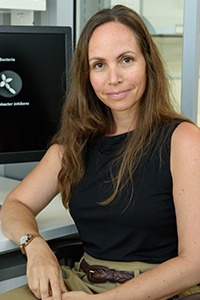
Dr. Einat Segev
The life and death of algal blooms
Single-cell marine algae may be small, but altogether, they have a huge ecological impact. Prof. Vardi is an expert on algal blooms—colonies of algae that can stretch for thousands of miles over the ocean surface in layers up to 50 meters in depth, and can even be seen from space. These blooms are responsible for half of all the photosynthesis on Earth, and also play an important role in the planet’s carbon, oxygen, phosphate, nitrogen, and sulfur cycles.
Infections by viruses can spread quickly among the algae, causing the death of these massive blooms in a matter of days. Prof. Vardi investigates the molecular basis of such infections, as well as the effect bloom demise has on carbon transfer—a critical factor in the maintenance of a stable climate.
The role of aerosols
Liquid and solid particles called aerosols that hover over the surface of the ocean are among the most significant factors in climate research, but their chemical properties and physical dynamics are poorly understood.
Aerosols affect climate both directly, by scattering and absorbing sunlight, and indirectly, by their effects on clouds and incoming solar radiation. Using a combination of state-of-the-art chemistry and microbiology tools, Prof. Rudich is working to understand the role of oceanic aerosols, as part of the overall profile of emissions that contribute to air pollution, drive global climate change, and affect human health. His discoveries about atmospheric aerosols contribute to a scientifically based understanding of global climate dynamics, as well as these aerosols’ impact on terrestrial and marine ecosystems.

Prof. Ilan Koren
The ocean’s timeline
To understand modern-day climate change, we need to compare these dynamics to shifts in climate that occurred over the course of our planet’s history. Prof. Aldo Shemesh is clarifying the picture, using oxygen isotopes from sediments to reconstruct continental paleoclimate. He studies variations in such phenomena as surface water temperatures and rates of ice melting which, over time, impact concentrations of atmospheric carbon dioxide.
Prof. Shemesh is now developing two new approaches. First, he is analyzing oxygen isotopes left behind in the mineral skeletons of a family of marine protozoa called radiolaria. He is also examining the chemical content of Mediterranean reefs constructed out of marine mollusk shells. Such shells can be used to reconstruct past sea surface temperature, productivity, CO2 levels, and continental runoff. Together, these approaches provide an enriched timeline of the chemical changes that have occurred in the ocean, and will help to put present and projected climate trends into historical context.
Extreme weather—the wave of the future?
Rising global temperatures are causing greater evaporation of water from the ocean, a dynamic that drives the formation of stronger and more frequent storms. Dr. Shira Raveh-Rubin studies the causes and dynamics of extreme weather. Her research focuses on the highly destructive cyclonic storms that often leave a trail of devastation, and which transport moisture and pollutants across long distances.
Working in collaboration with international teams, and using huge global meteorological datasets that contain observations collected over recent history, Dr. Raveh-Rubin hopes to develop new diagnostic tools for understanding specific features of weather systems. Her ultimate goal is to better identify the factors and mechanisms that determine the location, intensity, and frequency of extreme climate events such as intense droughts, floods, heavy precipitation, and dangerous storm systems. This in turn may lead to the development of early-warning measures that would improve our ability to prevent weather-related disasters.
Not your grandmother’s Dead Sea
The time it takes to traverse exposed land to reach the water’s edge provides poignant evidence of the “retreat” of Israel’s Dead Sea from its previous wide expanse to its present, much-diminished dimensions. Dr. Yael Kiro is looking into the history of how this happened.
A geochemist who uses chemical clues to read the environmental record preserved in groundwater, sediments, and rocks, Dr. Kiro has examined 1,500 feet of core samples from the bottom of the Dead Sea. An international study she co-led based on this data showed evidence of two “mega” droughts: one that began approximately 120,000 years ago when average global temperatures rose about four degrees Fahrenheit, and another about 10,000 years ago following the last ice age.
With current water levels in the Dead Sea dropping roughly one meter per year since the 1950s, and rainfall down about 10 percent on average, Dr. Kiro’s research suggests that the region could be headed for another serious dry spell. She is currently expanding her research to study the circulation of seawater and groundwater in aquifers beneath the coastline, including the Mediterranean.

Dr. Yael Kiro
Mineral mechanisms
With rising levels of greenhouse gas emissions from human activity, sea water absorbs more CO2 from the atmosphere. This lowers pH, causing a higher acid content in the ocean. One of the results of this ocean acidification is reduction in the concentration of calcium carbonate in marine ecosystems.
Dr. Assaf Gal studies how living organisms use minerals such as calcium carbonate to build structures ranging from the delicate shapes of single-celled marine algae to the bones of elephants. His work focuses on two groups of mineralizing marine algae called coccolithophores and diatoms, which live near the ocean’s surface, and produce their energy through photosynthesis. Dr. Gal discovered a previously overlooked organelle where calcium is stored in intracellular reservoirs, and also identified a number of macromolecular recognition mechanisms that control their crystallization. His work is clarifying the mechanisms of mineral deposition that drive the creation of calcium carbonate structures in marine organisms, and at the same time, is helping to characterize the role these organisms play in the overall balance of marine ecosystems.
Bacteria-algae ‘buddy system’
Marine bacteria have been affecting the growth, development, and death of algae throughout the history of our planet. This is the research focus of Dr. Einat Segev. Geologists study algae because the chemistry of algae’s debris, deposited over millions of years, reflects the temperature of the ocean at the time that the algae were still alive. This makes algae a “paleo proxy” for climate scientists; they use the algal remains as a tool for estimating ancient conditions, and comparing them to current trends. In her postdoctoral research, Dr. Segev identified a symbiotic relationship between marine bacteria and algae that causes algae to “record” the wrong temperature.
After creating a research model that accurately reflects algae-bacteria interactions, Dr. Segev is now studying how algal debris can be deciphered to reveal long-ago changes in ocean temperature. Research based on Dr. Segev’s model may contribute to our understanding of both historical climate trends, and the impact of climate change on microbial life at sea.
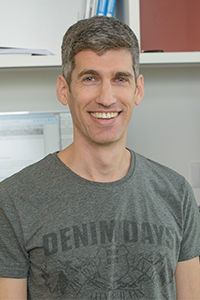
Dr. Assaf Gal




